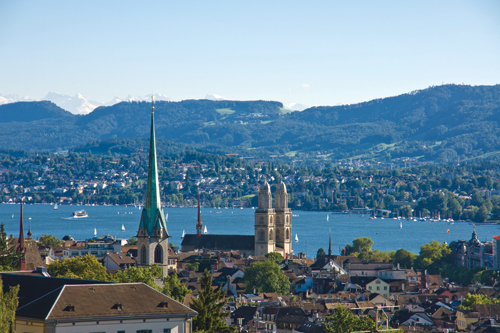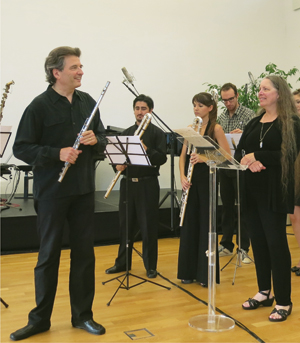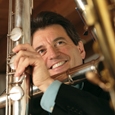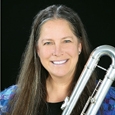
Swiss flutist and composer Matthias Ziegler (b. 1955) teaches at the Musikhochschule Winterthur Zurich and performs throughout the world. He was formerly solo flutist with the Zurich Chamber Orchestra. While his repertoire includes the traditional and contemporary literature for the flute, his search for new sounds has broadened the expressive potential of the traditional flute and the electroacoustically amplified contrabass flute. Composers Michael Jarrell (Switzerland), Benjamin Yusupov (Tajikistan), Matthias Rüegg (Vienna Art Orchestra) and Mark Dresser (United States) have written flute concertos for him.
What inspires you to create a new piece?
Sometimes after a concert people ask if there is a possibility of their playing my pieces. Since I often improvise music, I have to write my ideas down. Some of improvising is hard to put on paper, however, so the pieces may change as I write them out. I suppose this is a good exercise in learning to nail down the ideas.
Sometimes the music that inspires me uses particular flutes that make special sounds. Non-flute music is a big source of inspiration. It might be Iranian, South American, or Renaissance music that I hear and then make a sketch of it on my instruments.
The process of writing the music down on a piece of paper is the last step of composing. You get the idea, make sketches and try the idea out from one end. Putting it down on paper means you know what you are going to write. It is like architecture. It is not just designing the house, architecture is the whole process of getting to the point where you are able to put it down on paper, to condense the idea.
I might pick up old ideas from a recording I made or a piece that I wrote down earlier. Sometimes it is just a set-up of instruments that inspires me. For example, with Low Flutes at High Tides, I was asked to write seven or more parts and use alto, bass, contra alto and contra bass with no electronic equipment. It was interesting to do something for just low flutes. It was very different than an open set-up when I can include any instruments I want to use.
 What challenges did you face when you wrote Low Flutes at High Tides?
What challenges did you face when you wrote Low Flutes at High Tides?
When I write down “shshshshsh” in the German way, the Americans read it differently. Americans think it should sound like “she she she she” and I wanted something softer, more like the “sh” in shoe. The lips are more forward and the sound that is produced is less bright, more caressing. As soon as you include language with an effect, you have to be very careful and, of course it came out wrong so I had to correct it.
I felt that some people would not be able to do the effects I wanted very well; they would need lots of practice. So I tried to be clearer and simpler to get the effect that I wanted. Some of the passages I wrote were complex, and I tried them out with my flute class in Zurich. Some of them sounded a little different from what I thought, but the result was still interesting.
There were problems with sounds that transform while you play, like going from clear pure flute sounds to air noise. I found out how to make it simpler for the individual players and get the same result at the end. Instead of asking everyone to change from a clear sound to a breathy sound, I found if I let two people keep the clear sound and asked for airy, unfocused tone from six people, the overall result is a breathy sound. That was very nice to discover. Not everyone has to make a change in order for the new texture to be effective.
How did you discover the unusual percussive and vocal sounds that no one knew the flute could make?
Some of them I found improvising with the instrument. I discovered others when I was practicing and listening very closely or by putting my ear on the flute while I was sitting in the orchestra during boring rehearsals with choirs. I was listening to the choirs through my tube and hearing harmonics. Then I started singing into the instrument myself and using different fingerings to produce various harmonics.
Another source is the solo flute repertoire. In the beginning of the 20th century we have the Debussy Syrinx which is clear, straight flute playing. Then we have the Varese Density 21.5 that uses key clicks. Next is Andre Jolivet who uses flutter tonguing and also harmonics. I would say the next solo piece in line is the Berio Sequenza. Here you get multiphonics, frullato (singing while playing) and key clicks. After this you get Takemitsu using the voice, lots of multiphonics, and frullato; he is almost using the whole palette. In the 1970s Heinz Holliger was already using tongue rams. In addition to learning the techniques, flutists should know the musical potential of each one by using it throughout the instrument.
I found out which sounds survived live on stage and which were rather private and soft. A big step was putting microphones inside the instrument, and all those sounds came to life. The sounds got to a level that people could hear them. At that point I started making a library of my sounds. I defined them, wrote them down, recorded how long I could play them and outlined the possible dynamic range. It is a lot of work and research, but I enjoyed investigating a long history of wonderful flute playing.
Did you put microphones inside the flute because you heard a sound that was so soft you knew that would be the only way it could be heard?
Well, it could be like that. It sounds very logical, but my entire life, I always took things apart and put them together again. I have a basic technical interest in how things work.
After graduating from the university in Freiberg, I went on tour with Andreas Vollenweider who played electro-acoustic harp. He had wonderful technicians, and this was the place where I heard that playing my flute on a live stage could sound like sitting in front of a stereo. This was a wonderful thing because I realized that the clarity of sound, this quality of the details of sound, could be attained. After this tour, together with the technicians of Andreas Vollenweider, I developed this amplified flute.
The summer I was working on this, I was at the concert of a didgeridoo player who put a microphone at the end of his tube and got the most wonderful sounds. That same night I went home and put a microphone at the end of my flute on the inside. Technology was at a point where microphones were small enough that one could think about putting them inside the flute.
I experimented all summer. I started by taking off trill keys, putting cork in the opening and placing a microphone in this cork. From there I kept going with help from friends in electronics and flute-making fields. It became a huge, creative motor. I was playing traditional repertoire and co-founded the contemporary music group I am still with 20 years later. I also was principal flute with the Zurich Chamber Orchestra and teaching. At that point, I really felt like that creative motor was the thing that kept me going. It was fantastic. I will always think I was very lucky to have discovered something like this.
How do you develop your experiments with tone colors, rhythmic patterns, layered harmonies and percussive effects into a piece?
What I like is to improvise and record it and then leave it overnight. I start the next morning with the recording and write down elements, sketches, like four bars or a phrase. I write some comments on the page and add colors. Then I take those sketches and see if I can notate them in the computer. I do not want to spend time developing an idea only to discover at the end that it cannot be written down.
I try out new ideas in concerts and then listen to what I did. Developing an idea in front of people is much more reliable than doing it alone at home. So I go with a first catch on stage and see what the reaction is. I record this concert, go home and keep working. All these pieces constantly change. I do not compose one measure after another; it is half a bit here, half a bit there.
You wrote a solo bass flute piece for me, Voices, that includes a whistle created by inhaling through the flute. What other interesting sounds have you discovered lately?
I am looking at sounds that combine different techniques. For example it might be a trill played while doing something different at the same time with articulation. There is some of that in Voices. There is a lip slap that does not really lock in with what is occurring with the fingers. I am looking at mixing gestures in order to get a new sound.
Why do you use Renaissance music in your compositions?
I was not listening much to Renaissance music until I played the low flutes. The sound of the low flutes reminded me of the viola da gamba.
I played Bach Sonatas and gamba sonatas with the bass flute; it worked perfectly and is very beautiful. I played music from the Tratado de Glosas, a collection of music for viola da gamba published by Diego Ortiz in 1553, and this inspired me to learn more about Renaissance music as well. I started working with Rolf Lislevand, a Norweg-ian lute and theorbo (long-necked lute) player. He is an expert on Renaissance and early music. We started playing together at my festival in the Swiss mountains and have continued to play together for the last five or six years.
You used a loop station in the Yusopov Concerto at the New York NFA convention. What constitutes an effective pattern to use on a loop station?
(Editor’s note: a Loop Station is a type of recording device. You start by recording and saving one pattern, then add more. It can play patterns individually or simultaneously and will repeat until you signal the device to stop. Foot pedals control the functions of the machine. A YouTube video of Matthias playing the Yusopov Concerto with the Belgrade Philharmonic can be found by searching for “Jusupov: Nola.”)
Simplicity is a big issue when deciding on a pattern and you must be able to play them really precisely. You are going to hear your playing over and over again so make sure it is not limping. It can be something like a shuffle going fwofwofwofwofwo; it can also be more complex. The important thing is that you remember there will be other layers on top of it. Do not fill all the gaps with your loop pattern because you are going to be a very unhappy flute player if your loop covers everything.
Do you have favorite rhythmic patterns?
I am very interested in polyrhythmic patterns because you can twist them around and everybody will hear how the patterns contrast with each other and how they combine. Everybody can sit on another leg of it by listening just to one layer of the pattern. I love to play polyrhythms like four against five against six, and I like the ambiguity that is within the polyrhythm. There are many examples of this in Voices. One of the easiest places in the piece is where I have a rhythmic pattern in triplet 16ths in the fingers against a pattern of vocal sounds written as straight 16ths and 32nds. (see below) The air produces an effect and the sound intersects with the fingered notes, sometimes together, sometimes not.

This excerpt is from Voices for solo bass flute, premiered at the 2013 New Orleans convention by Chris Potter and is an example of the use of polyrhythms. The top line contains the vocal effects which are rhythmically independent of the fingered pitches shown on the bottom line.
Why do you have a laptop on stage when you perform?
The laptop runs my sound card. The microphone signals go through the sound card to the computer and this basically is a mixing table. As I am using foot pedals for the faders, I need to have a whole midi set-up and it is the most elegant way to do this. A laptop is the most compact equipment I can carry with me. I travel a lot and have to be able to get on a plane with not too much weight. Already I am at the limit: I have my checked luggage full of pedals and wires and equipment stands. I am carrying so much weight on my body just with electronic equipment that a laptop makes sense.
Have you ever considered writing for instruments other than flutes?
I hesitate and maybe should write more. I wrote a piece for double bass, flute, drums and trombone but this is composing for improvisation that just defines fields. For example, I will tell the trombone player “Look, this is the range. Within this range, play short notes.” I give the pianist a cluster and say “vary the color of it by playing more or fewer notes together.” I describe what I want, rather than compose. If I were to have to write down a whole piano accompaniment that would be complex, and I cannot do that. Being a composer is still a profession. I do not call myself a composer, I am much more of a hunter and collector of ideas. I see how much I have to know about my instrument to be able to write for it. I do not know if I could get to a point where I would get to know the string instruments as well as I know the flute.
If I look at contemporary composers, really good composers like Heinz Holliger, he is able to show all the effects of the violin he writes down. He goes to the violinist in the ensemble and says “please give me your violin and I will show you how we do this.” He can play it on every instrument. It is really impressive. So it is fine for me to write for the flute because I know the instrument. Everything else is for the next life.
There has to be another reason than just a commission to compose. You have to have an interest in putting your music down on paper. The field between improvisation and composition is a very interesting one. If I reduce it to one question it is, “how little do I need to write down to get a maximum of complexity?” Or maybe “how complex can I write simplicity that it still makes sense?” Some contemporary composers are not complex, they are just complicated.
I went to school and had a teacher to help me learn how to play the flute, but the real learning started afterwards. The input I got from conductors, composers, and fellow musicians was invaluable. I was constantly improving, learning and experimenting. Playing both improvised music and notated contemporary music, I learned so much. It is not that you go to school and then you just play what is put in front of you, you are constantly questioning.
Recent Recordings
Ziegler’s most recent CD is with the Casal Quartet and features works by Mozart. Other recent CDs included La Rusna and Tidal Affairs and are available from Leo Records. The Dutch online TV station Zappbach-TV has published a documentary about his collaboration with flutemaker Eva Kingma. Matthias performs on bass and contrabass flutes, as well as on his own invention, the Matusiflute, a uniquely designed instrument with a vibrating membrane. Contact Ziegler through his website www.matthias-ziegler.ch.






